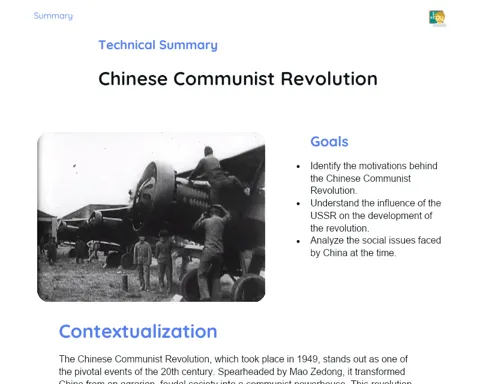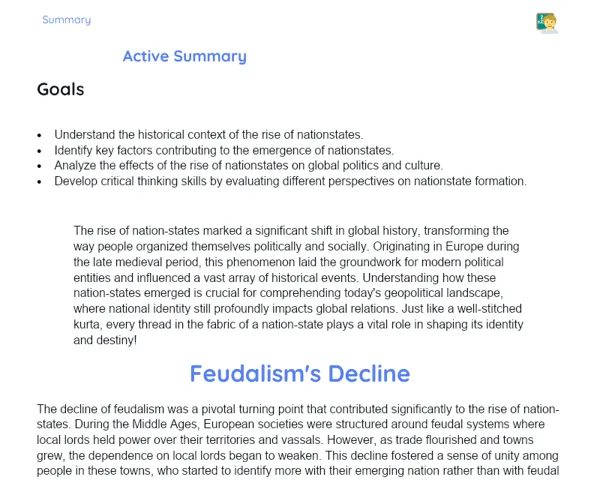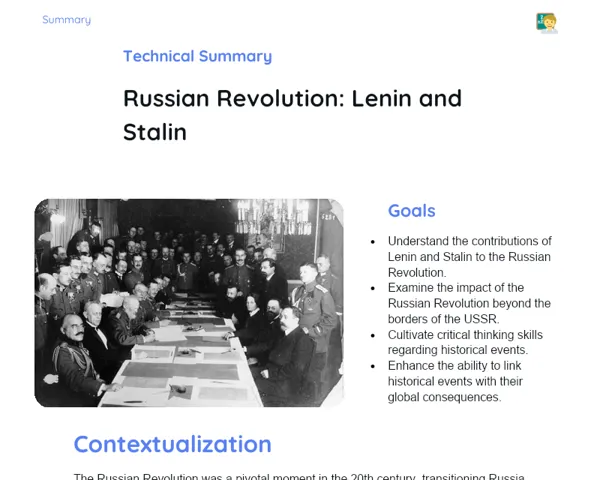Goals
1. Identify the key events and processes that led to World War I.
2. Understand the central conflicts and immediate impacts of the war.
3. Analyze the consequences of the post-war period and its implications on the world stage.
Contextualization
World War I, often referred to as the Great War, stands as one of history’s most cataclysmic conflicts. This era was characterized by a plethora of political, economic, and social changes that fundamentally reshaped the globe. Gaining insight into the background of World War I aids in understanding how tensions among major European powers, military alliances, rampant nationalism, and territorial disputes led to such a large-scale conflict. Noteworthy events, such as the rivalry between Germany and France over Alsace-Lorraine and the assassination of Archduke Franz Ferdinand of Austria, were pivotal in igniting the war. This awareness is crucial for analyzing how historical errors continue to influence contemporary issues and potential future outcomes.
Subject Relevance
To Remember!
Tensions Among the Great European Powers
The rising tensions among major European powers during the early 20th century were significant catalysts for World War I. The fierce rivalries and competition among nations like Germany, France, Great Britain, Russia, and Austria-Hungary fostered an atmosphere of suspicion and hostility. Disputes over territory, economic interests, and military capabilities intensified these tensions, pushing nations toward impending conflict.
-
Competition for colonies and essential resources.
-
Historical rivalries, such as that between France and Germany over Alsace-Lorraine.
-
Arms race and an increase in military expenditures.
Military Alliances
Military alliances played a crucial role in precipitating World War I. The Triple Alliance (Germany, Austria-Hungary, and Italy) and the Triple Entente (France, Russia, and Great Britain) formed opposing blocs of power. These alliances aimed to secure mutual safety but also meant that any conflict between two countries could rapidly pull in all members of the alliances.
-
Triple Alliance: Germany, Austria-Hungary, and Italy.
-
Triple Entente: France, Russia, and Great Britain.
-
Domino effect: a localized conflict quickly evolved into a global war due to these alliances.
Heightened Nationalism
Intensified nationalism was another significant factor that fueled World War I. Nationalist movements propagated notions of national superiority and aspirations for territorial expansion. This generated both internal and external tensions, particularly within multi-ethnic empires like Austria-Hungary and the Ottoman Empire, where various ethnic groups strove for self-determination.
-
Nationalist movements emphasized national superiority.
-
Desire for territorial expansion and unification of ethnic groups into a single state.
-
Internal tensions in diverse empires resulting in conflicts and instability.
Assassination of Archduke Franz Ferdinand
The assassination of Archduke Franz Ferdinand of Austria on June 28, 1914, served as the ignition point for World War I. Killed in Sarajevo by Gavrilo Princip, a Serbian nationalist, this event propelled Austria-Hungary to declare war on Serbia, triggering a chain reaction of war declarations among nations bound by military alliances.
-
Assassination carried out by Gavrilo Princip, associated with a Serbian nationalist group.
-
Austria-Hungary’s declaration of war on Serbia following the assassination.
-
Alliances transformed a local conflict into a widespread global war.
Treaty of Versailles
The Treaty of Versailles, ratified in 1919, formally concluded World War I. This treaty imposed stringent conditions on Germany, including territorial losses, military restrictions, and extensive reparations. The resentment stemming from these conditions sown instability in Germany, paving the way for extremist movements and eventually the onset of World War II.
-
Imposition of severe penalties on Germany.
-
Loss of territory and demilitarization efforts.
-
Heavy financial reparations leading to economic and political turmoil.
Practical Applications
-
Case studies in International Relations focusing on diplomacy and conflict resolution.
-
Political risk assessments for businesses to anticipate and mitigate possible international crises.
-
Adaptations of military technologies for civilian applications, such as aviation and wireless communication.
Key Terms
-
Triple Alliance: Military alliance comprising Germany, Austria-Hungary, and Italy.
-
Triple Entente: Military alliance formed by France, Russia, and Great Britain.
-
Nationalism: Ideology fostering allegiance and dedication to a nation, often linked to self-determination aspirations.
-
Treaty of Versailles: Peace treaty concluding World War I, imposing harsh conditions on Germany.
-
Assassination of Archduke Franz Ferdinand: Incident that triggered World War I on June 28, 1914.
Questions for Reflections
-
How did military alliances shape the outbreak of World War I, and how might they influence current global conflicts?
-
What present-day manifestations of heightened nationalism exist, and what potential consequences do they entail?
-
What insights into diplomacy and negotiation can we derive from the events that led to World War I?
Debate on Diplomacy and Conflicts
This mini-challenge seeks to deepen students' understanding of the background of World War I while highlighting the significance of diplomacy in preventing conflict.
Instructions
-
Divide the class into two groups: one representing the nations of the Triple Alliance, the other for the Triple Entente.
-
Each group should conduct quick research about their nations’ interests and demands during the pre-war period.
-
The groups will then engage in a simulated diplomatic conference, presenting their demands while seeking peaceful resolutions to avoid war.
-
Post-debate, students should reflect on the experience and propose which diplomatic strategies might have been employed to avert the conflict.



